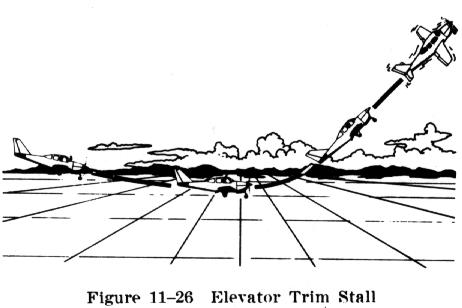
At a safe altitude after ensuring that the area is clear of other air traffic, the pilot should slowly retard the throttle, and extend the landing gear (if retractable gear).
 |
This demonstration maneuver shows what can happen when full power is
applied for a go-around and positive control of the airplane is not maintained.
Such a situation may occur during a go-around procedure from a normal landing
approach or a simulated forced landing approach, or immediately after a
takeoff (Fig. 11-26). The objective of the demonstration is to show the
importance of making smooth power applications, overcoming strong trim
forces and maintaining positive control of the airplane to hold safe flight
attitudes, and using proper and timely trim techniques.
At a safe altitude after ensuring that the area is clear of other air traffic, the pilot should slowly retard the throttle, and extend the landing gear (if retractable gear). |
During this simulated final approach glide, the throttle is then advanced smoothly to maximum allowable power as would be done in a go-around procedure. The combined forces of thrust, torque, and back elevator trim will tend to make the nose rise sharply and turn to the left. To demonstrate what could occur if positive control of the airplane were not maintained, no immediate attempt should be made to correct these forces.
When the throttle is fully advanced and the pitch attitude increases above the normal climbing attitude, and it is apparent that a stall is imminent, forward pressure must be applied to return the airplane to the normal climbing attitude. While holding the airplane in this attitude, the trim should then be adjusted to relieve the heavy control pressures and the normal go-around and leveloff procedures completed.
The pilot should recognize when the stall is imminent and must take prompt action to prevent a completely stalled condition. It is imperative that a full stall not occur during an actual go-around from a landing approach, since the amount of pitch change necessary for recovery may be such that the airplane would dive into the ground.